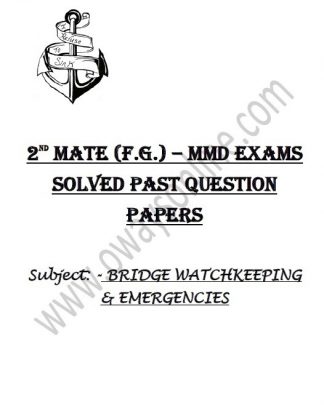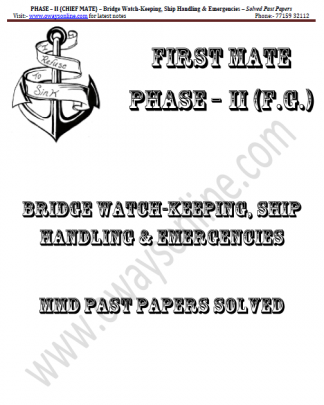Principle & working of Electromagnetic Speed Log:
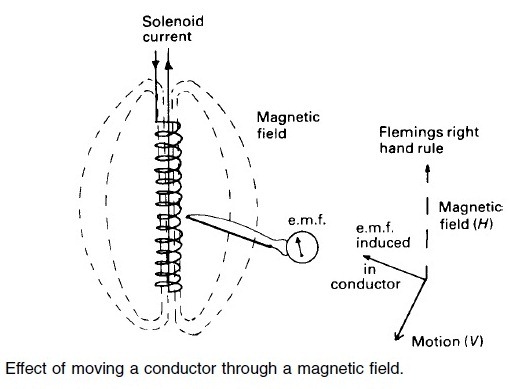
- The electromagnetic speed log is based is upon the induction law, which states that if a conductor moves across a magnetic field, an electro motive force (e.m.f.) is set up in the conductor.
- Alternatively, the e.m.f. will also be induced if the conductor remains stationary and the magnetic field is moved with respect to it.
- The induced e.m.f. is directly proportional to the velocity.
- Velocity when integrated with time gives distance
- The induced e.m.f. ‘E’ is given by the following:
- E = F X L X V
- Where F = magnetic field
- L = the length of the conductor
- V = the velocity of the conductor through the magnetic field.
Constructional Details of an electromagnetic log sensor: This type of log consists of
- Sensor
- Amplifier
- Indicator
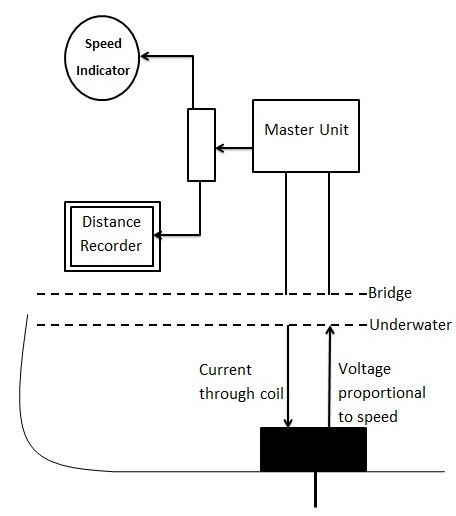
Working of Electromagnetic Speed Log:
- An Electromagnet consisting of a coil carrying alternative Current (A.C.) generates a vertical magnetic field in the water around the probe.
- The SW Conductor moving horizontally through this magnetic field has an electromotive force induced into it proportional to the seed of the vessel. In the EM log the ‘F’ and ‘L’ are maintained constant, therefore the induced e.m.f. is directly proportional to the velocity ‘V’, which is the velocity of the vessel through the water.
- The speed output from an EM log depends upon the water flow by way of the sensors.
- This type of log can give only speed through water and is greatly affected by the current flowing under the ship.
- The induced e.m.f. and hence the speed indication will vary with the conductivity of the water.
- This e.m.f. is picked up by 2 electrodes.
- This induced e.m.f. is very small hence the amplification is required.
- The amplified signal thus drives the mechanism which is connected to indicator.
- Hence, the induced e.m.f. which is directly proportional to the velocity is finally displayed on the indicator.
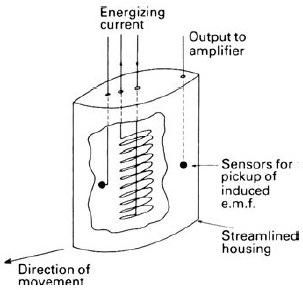
More information:-
- The Log Extends up to about 20 cm outside the hull.
- It should be retracted in case of reduced UKC & before proceeding to dry dock.
- Normally retracted from the engine room.
- If sensors are also fitted athwartship, the speed in athwartship direction also can be displayed.
Errors / Limitations of Electromagnetic Speed Log:
- Siting of the probe is critical. This is so since if too close to the hull then due to the non-linearity of the hull form the speed of the water flow may give a wrong representation of the vessels speed. This is minimized by careful siting of the sensor as well as by calibrating the instrument while installation.
- Pitching and Rolling also give rise to errors however these are reduced by having an electrical time constant that is longer than a period of vessel motion. A well-adjusted log can have an accuracy of better than 0.1 percent of the speed range.
- Sign of Speed, it can show astern speed as well, but without sign if AC current is used, if DC current is used to create the magnetic field it will show sign of speed range. This type of log can give only speed through water and is greatly affected by the current flowing under the ship.
- While navigating in area with greater current, one must exercise precautions.
Advantages of Electro-magnetic log with Doppler log:
- No moving parts
- Less affected by sea growth than Pit sword
Disadvantages of Electro-magnetic log with Doppler log:
- Salinity and temperature of water affects calibration.
- Measurements affected by boundary layer, (water speed slowed down close to the hull by friction).
- Provides boat/ship speed relative to water not ground. Current affects accuracy.
Difference between “Water Track Speed” and “Ground Track Speed“:
Water Track Speed:- In open seas, the sound pulse from the Doppler transducer may not reach the bottom, but get totally internally reflected from a layer of water in between. This is known as the echo from the ‘Water Track”. When the sound is bounced off a water layer, called a water track, speed indicated is the ‘Speed through Water”. or from a layer of water and the echo is at a higher frequency. The frequency of the echo from the water track will follow the same Doppler principles as the echo from the bottom track. However, the speed measured from the ‘water Track’ will not be ‘Speed over the Ground’, but it will be ‘Speed through Water’.
Ground Track Speed:- Speed over ground is the speed of the ship with respect to the ground or any other fixed object such as fixed buoy or island. Speed through water is the speed of the ship with respect to the water such as anything floating on water. A ship with her engine stopped in water with 2 knots currents will have zero speed through water but will have 2 knots speed over ground.
